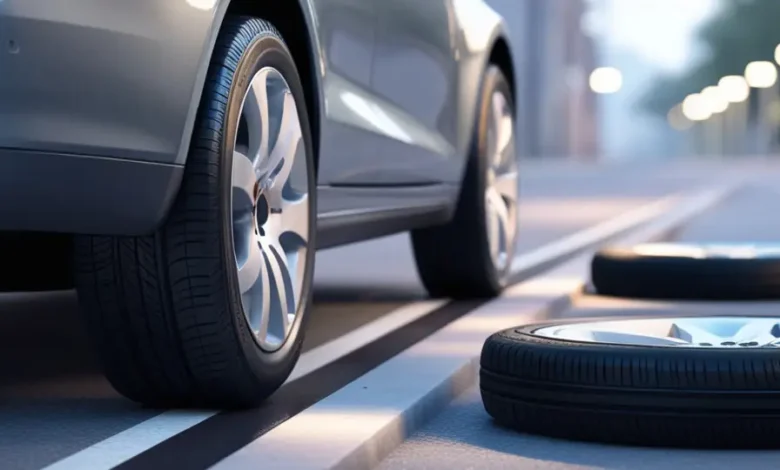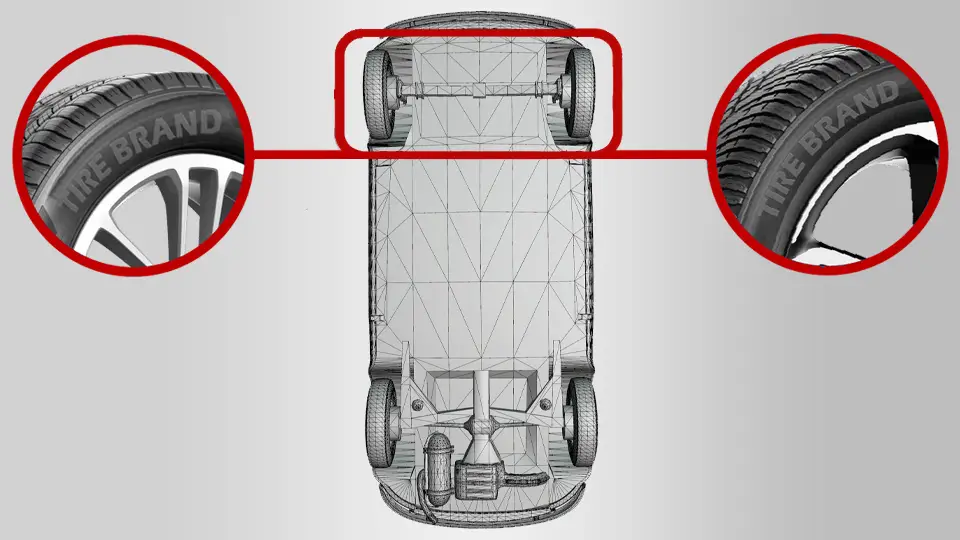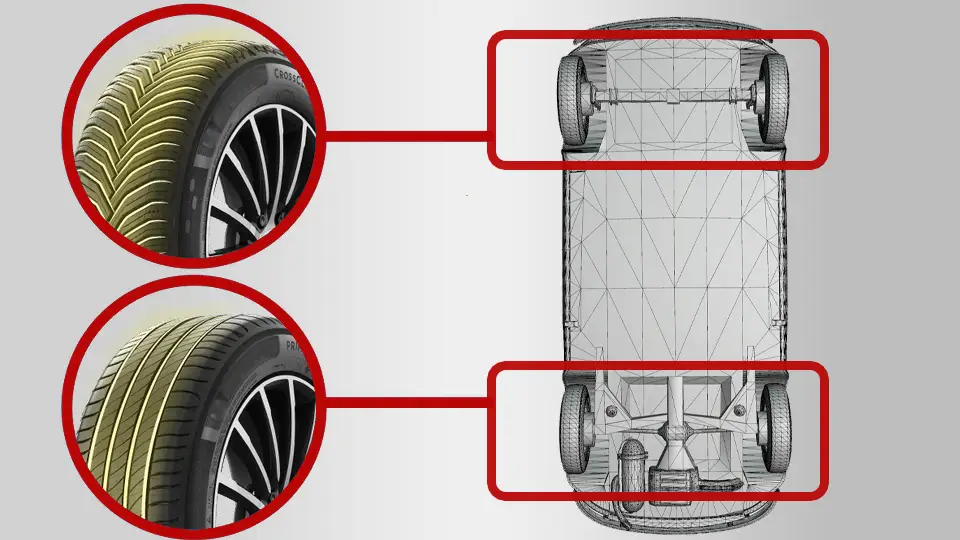
Introduction
When you’re driving, situations like uneven tire wear or unexpected punctures can lead to a need for different size tires on the front and rear axles. In some cases, you may even encounter vehicles with factory-installed variations in tire sizes. However, it’s crucial to understand how driving with mismatched tires can affect your vehicle’s performance and safety.
Whether it’s due to emergency situations or specific vehicle design, having different size tires can impact the way your car handles on the road. This makes it essential to follow manufacturer guidelines closely and understand the safety implications before making any changes.
In this blog, we will explore the safety aspects of having different size tires on your vehicle, covering the pros, cons, and key considerations.
Understanding Tire Sizes and What They Mean
To fully grasp the impact of having different size tires on your vehicle, it’s essential to understand how tire sizes are measured and what those numbers on the sidewall represent. Each tire has specific dimensions that influence how it fits on your vehicle and affects overall performance.
Take, for example, a tire marked 225/45R17. These numbers represent key details about the tire’s size and capabilities:
- Width: The first number (225) refers to the tire’s width in millimeters. This measurement plays a significant role in how much of the tire makes contact with the road, influencing traction and handling.
- Aspect Ratio: The second number (45) is the aspect ratio, which tells you the height of the tire’s sidewall as a percentage of the tire’s width. In this case, the sidewall height is 45% of the 225 mm width. This ratio impacts how the tire absorbs shocks from the road and can affect both ride comfort and performance.
- Rim Diameter: The last number (17) indicates the rim diameter in inches, which shows the size of the wheel the tire is designed to fit. Ensuring rim compatibility is crucial for maintaining proper handling and stability.
These measurements are key to understanding tire size compatibility. Installing tires with dimensions that don’t align with your vehicle’s specifications can lead to issues with performance, safety, and even legal concerns. Always refer to the manufacturer’s guidelines when replacing or changing tires to ensure a good match.
Factory-Installed Different Size Tires
It’s not uncommon to find factory-installed different size tires on certain vehicles, especially high-performance cars and trucks. Manufacturers sometimes design these vehicles with different tire sizes on the front and rear axles for specific reasons that enhance the vehicle’s performance.
For instance, many sports cars are built with wider rear tires and narrower front tires. This difference helps optimize traction, especially in rear-wheel-drive models. Wider rear tires can handle more power and improve grip, which is crucial when accelerating quickly or driving through sharp corners. In contrast, narrower front tires allow for more precise steering and better control.
Different size tires on front and rear axles can affect your vehicle’s balance and safety—always follow manufacturer guidelines.
Trucks and other heavy-duty vehicles may also have different size tires for stability reasons. For example, larger tires at the back help carry heavier loads, while smaller front tires enhance maneuverability.
These size variations are specifically designed to suit the performance needs of each vehicle. However, when replacing tires, it’s essential to follow the manufacturer’s guidelines closely to maintain the vehicle’s balance and handling. Ignoring these specifications could result in safety issues or uneven wear, diminishing the benefits of having sports car tire sizes or heavy-duty truck tires.
Is It Safe to Mix Different Tire Sizes?
Mismatched tires on the same axle can lead to dangerous handling and braking issues, compromising your safety on the road.
The question of whether it’s safe to mix tire sizes largely depends on the type of vehicle you drive and how the tires are arranged. Different axles and wheel-drive systems react differently to mismatched tires, and while it’s sometimes possible to mix sizes, there are crucial safety considerations to keep in mind.
Front-Wheel Drive
In front-wheel-drive vehicles, the front tires handle most of the power and steering. If the front tires differ significantly from the rear ones, the vehicle’s handling can be thrown off balance, potentially reducing traction and control. While mixing sizes in the front and rear may be temporarily acceptable, especially in an emergency, it’s important to match tire sizes on the same axle to avoid uneven wear and safety risks.
Rear-Wheel Drive
In rear-wheel-drive vehicles, the rear tires carry more of the load and provide power to the vehicle. Having different tire sizes on the rear compared to the front can affect the car’s acceleration and braking, but it’s usually safer than mismatching tires on the same axle. For optimal performance and different tire sizes front and rear safety, it’s best to follow manufacturer recommendations and keep size differences to a minimum.
All-Wheel Drive
For all-wheel-drive (AWD) vehicles, mixing tire sizes is more complicated. AWD systems distribute power to all four wheels, and any size difference can create mechanical stress on the transmission and suspension. In AWD vehicles, it is typically not safe to mix tire sizes, as even small mismatches can cause uneven tire rotation, reducing traction and potentially leading to costly damage over time.
When Is It Acceptable to Mix Tire Sizes?
While mixing tire sizes may be necessary in emergency situations, such as when using a spare tire, it should only be a temporary solution. In the long run, driving with mismatched tires can lead to uneven wear, decreased handling, and potential safety risks. To ensure different tire sizes front and rear safety, it’s always best to consult a tire professional and replace all tires with the correct size as soon as possible.

Why You Should Avoid Mismatching Tires on the Same Axle
Why You Should Avoid Mismatching Tires on the Same Axle
One of the most critical rules in tire safety is never to run mismatched tires on the same axle. While having different sizes on the front and rear axles can sometimes be acceptable, mismatching tires on the same axle—whether in size, brand, or tread pattern—poses serious risks to your vehicle’s performance and your safety.
Handling and Braking Issues
When you have mismatched tires on the same axle, the tires will respond differently to the road, causing uneven traction. This imbalance can significantly affect your car’s ability to handle turns and respond quickly to changes in direction. Additionally, mismatched tires often have different braking characteristics, which can increase stopping distances and reduce your control in emergency situations.
Safety Concerns
Unequal tires on the same axle can also lead to irregular tire wear, which compromises safety in both normal and hazardous driving conditions, like rain or snow. Over time, these variations can put extra strain on your vehicle’s suspension and transmission, leading to more severe mechanical issues down the road. To avoid same axle tire risks, always ensure that the tires on each axle are identical in size, tread pattern, and wear condition.
Legal Restrictions
In some regions, like the UK, there are strict legal restrictions on tire mismatching. For example, many laws prohibit mixing radial and cross-ply tires on the same axle. Failing to adhere to these regulations can not only affect your vehicle’s performance but may also result in fines or penalties.
For optimal safety and compliance, it’s best to replace both tires on an axle at the same time, ensuring they match in every way.
Effects of Driving with Different Size Tires
While driving with different size tires may seem like a convenient solution in certain situations, the long-term consequences can be severe. The strain placed on your vehicle’s systems due to mismatched tires often leads to costly damage and safety hazards.
Wear on Suspension, Transmission, and Brakes
One of the major effects of different size tires is the wear and tear on your vehicle’s mechanical systems. A tire size mismatch can create uneven pressure on the suspension, causing it to work harder to maintain balance. Over time, this can lead to alignment issues and premature wear of suspension components.
The transmission, particularly in all-wheel-drive (AWD) vehicles, is also at risk. AWD systems rely on even tire rotation, and when one tire is larger or smaller, it forces the transmission to compensate, leading to excessive stress. Similarly, mismatched tires affect braking performance, potentially making it more difficult to stop quickly, which increases the chances of accidents.
Safety Risks in Hazardous Conditions
In hazardous conditions like rain or snow, mismatched tires can become even more dangerous. Tires with different sizes or treads will not grip the road evenly, reducing traction and making it harder to control the vehicle. This is particularly dangerous during sudden maneuvers or when stopping on slippery surfaces, as uneven performance across the tires can cause the vehicle to skid or slide uncontrollably.
To minimize the tire size mismatch impact on your car and your safety, it’s important to replace all tires with properly sized, matching versions as soon as possible.
Best Practices for Managing Tire Size Differences
If you find yourself in a situation where you must use different size tires temporarily, it’s essential to follow a few best practices to minimize risks and maintain your vehicle’s performance. While mismatched tires are not ideal, these tips can help you manage the situation until you can replace the tires with matching sets.
Tread Depth Matching
When dealing with tire size management, one of the most important factors is tread depth. Even if the tire sizes differ slightly, ensuring that the tread depths are as close as possible can help maintain some balance. Ideally, the tread depth difference should be no more than 2/32 of an inch, as larger differences can cause uneven wear and handling issues. If you’re mixing new and used tires, aim for treads that are as similar as possible to prevent excess strain on your vehicle.
Consider Tire Brands and Models
Another crucial element of tire size management tips is to consider the tire brand and model. While it’s best to use the same tire across all wheels, if you need to mix brands, opt for tires with similar performance characteristics, such as tread pattern, load rating, and speed rating. The more aligned the specifications, the less impact the mismatched tires will have on your vehicle’s handling and safety.
Consult Tire Professionals
Always consult tire professionals for long-term solutions to mismatched tires to ensure optimal safety and performance.
For long-term solutions, always seek the guidance of tire professionals for mismatched tires. They can offer expert advice on whether your current tires are safe to drive on, or if they need immediate replacement. Professionals can also ensure that your tires are correctly balanced and aligned, reducing the strain on your car’s suspension and transmission. Additionally, they can recommend the best tires for your specific vehicle and driving conditions, ensuring optimal safety and performance.
By following these best practices, you can manage temporary tire mismatches more effectively and reduce the risks involved.

FAQs
1. Can I drive with different tread depths on front and rear tires?
2. is it safe to mix winter and summer tires?
3. What should I do if my car requires different size tires?
4. Can I mix different brands of tires on my vehicle?
5. What is the impact of driving with mismatched tires?
6. How often should I rotate my tires?
7. Are all-season tires suitable for winter driving?
8. Can I use a spare tire of a different size?
9. How do I know if my tires are worn out?
10. What is the correct tire pressure for my vehicle?
11. What should I do if I experience uneven tire wear?
12. How can I extend the life of my tires?
13. What are the signs of a flat tire?
Conclusion
In conclusion, understanding the implications of driving with different size tires on your vehicle is crucial for both safety and performance. While it may be necessary to use mismatched tires in temporary situations, drivers must recognize the potential risks involved. Key points include the importance of matching tread depths, adhering to manufacturer guidelines, and being aware of the axle type when considering tire sizes.
Tire safety tips emphasize that it’s always best to consult tire professionals for long-term solutions to mismatched tires. These experts can provide tailored advice and help you choose the right tires for your specific vehicle needs, ensuring optimal performance.
By prioritizing proper tire maintenance, you not only enhance your vehicle performance with different tires but also significantly improve your overall driving safety. Regular tire checks, rotations, and proper inflation can help you avoid issues related to mismatched sizes, leading to a safer driving experience.





